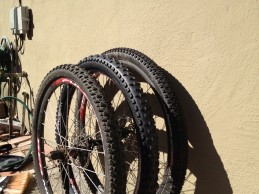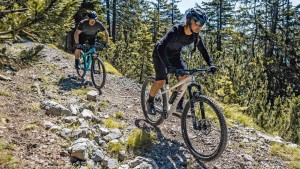This could kill all current gravel bikes
The wheel size debate, which has long been a headache for mountain bikers changing bikes, now seems to be threatening gravel after the introduction of a Moots prototype with 750d wheels, but does this new wheel size really make sense?

Will there be a change of wheel size on gravel bikes?
Let's go back in time for a moment, to the first decade of the century when the mountain bike world was turned upside down by the emergence of 29-inch wheels. What until then had been considered an untouchable standard, the 26-inch wheel size, was suddenly blown away by the emergence of big wheels.
What seemed like an eccentricity gradually became more and more common and soon people began to see that it worked, that it went over obstacles better, that it was easier to ride fast, in short, the beginning of the end of mountain biking as it was born in those distant late 70s and arrived in Europe in the 90s.
RECOMENDADO

The best apps for cycling and mountain biking

Black Friday 2025 cycling bargains: save on Garmin, POC, Maxxis and more

Black Friday Garmin 2025: the ultimate guide to choosing your GPS at the best price

Do you need suspension on your gravel bike?

A real workout saver of only 56 min on the turbo trainer

Which profile wheels to choose according to the area where you live: mountain, flat or coast

A change that, of course, was not without controversy on the part of cyclists who saw their bikes totally depreciated and began to run out of quality spare parts because of what many considered to be a mere invention of the brands so that we would all change bikes. Today, although bikes with 26-inch wheels are still marketed, they have been relegated to very basic ranges.
In fact, the controversy was reproduced shortly after, in the middle of the introduction of 29'' bikes, when it was also suggested that something in between would be a better solution: 27.5'' or 650b wheels. In fact, many brands opted to create ranges with both types of bikes, forcing them to duplicate models or, within the same reference, to equip the smaller sizes with 27.5'' wheels and the larger ones with 29'' wheels, claiming that this way they could maintain homogeneity in the geometries and the same fit.
Not even road cycling was exempt from this with some brands launching 650b wheel models in the small sizes supposedly to better adapt the bikes to women.

A proposal that has not caught on in any of the modalities, especially on the road where the 700 size has remained the unchanging standard since the origins of this sport, while in mountain biking 29'' wheels are the ones that have ended up taking the upper hand, except for exceptions such as enduro or downhill bikes that opt for 27,5'' in order to be able to mount huge balloon tyres without increasing the effective diameter and affecting the agility of the bike, or even the curious mullet combination in which the bikes mount a 29 front wheel and a 27.5 rear wheel.
Now it seems to be the gravel modality, the last to become popular as such less than a decade ago, which seems to be affected by these attempts to propose a new standard that, in reality, no one has asked for and no one sees the need for after Moots presented a prototype designed for 750d wheels with which they intend to achieve an effective diameter similar to that of 29-inch mountain bikes but without having to resort to large-balloon tyres.

Of course, few have taken it seriously that this 750d size could become a new standard, although, looking back, many did not take Gary Fisher, one of the historic pioneers of mountain biking, seriously when he started building prototypes with 29 wheels and claiming that this would be the future.
Obviously, the brands would be delighted if a new wheel size were to be introduced in gravel since it would mean, as it happened with mountain bikes, a total renewal of the cycling fleet as well as opening up new avenues of development at a time when gravel bikes, which after all, drink directly from road cycling, seem to be stuck in the same mantras when it comes to developing their designs.

However, going back to the question at the beginning, does the gravel really need larger wheels to be more efficient? Honestly, it's sobering. Abandoning a standard such as 700 wheels, with which really fast bikes are being built, to make gravel bikes even rougher and closer to the behavior of mountain bikes seems to make little sense, especially at a time when MTB hardtails are being pushed aside a bit in favor of modern XC fullies.
In general it seems to make little sense to want to make gravel bikes do what mountain bikes do when it was a discipline that was born out of the concept of solving a need in the vast plains of the western U.S. where you're riding on a perfectly paved road and then suddenly it turns into a dirt track for miles on end. Let's not forget that the first gravel bikes had tyres a little thicker than cyclocross tyres and were little more than big-bottom bikes designed for the classics but capable of accommodating those tyres.

If we stick to the essence of gravel, it makes little sense to create bikes with a specific wheel size, especially when one of the advantages of these bikes is the versatility they offer and that, with a simple change of wheels for smooth tyres allow us to have a road bike. In fact, let's not forget that in recent years gravel bikes have been debating whether the ideal was to use 650b or 700 wheels. Finally, the former have been reduced to a marginal use and only for those who use the gravel bike to do something more similar to mountain biking than gravel.
In any case, given the precedents of mountain bikes, it is impossible to say that 750d wheels will not succeed in the future, time will tell if we have to change bikes.